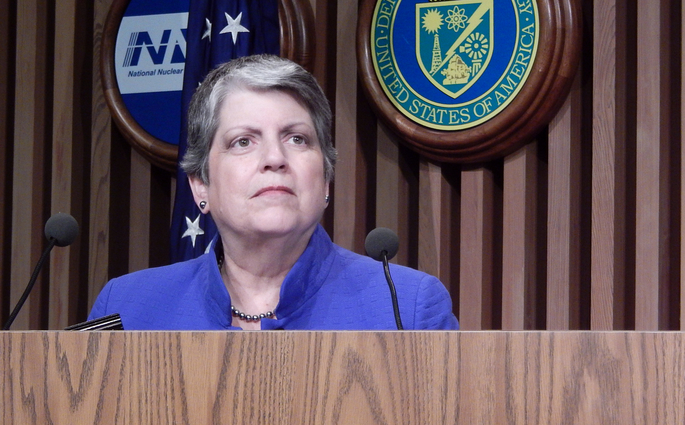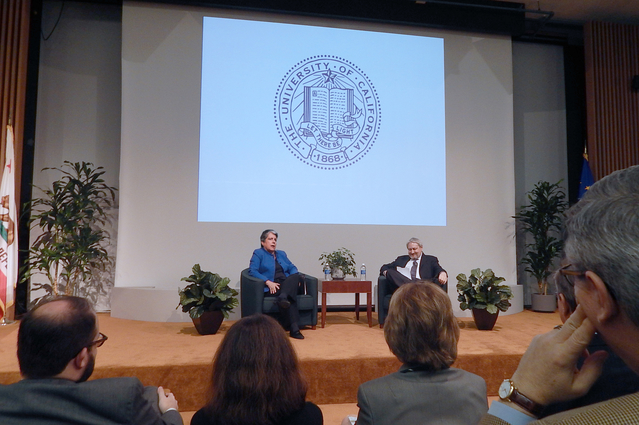UC president calls for greater university-Laboratory collaboration
In a presentation entitled "The Stars We Ignite," Napolitano said the University of California was built on the idea of "igniting stars" through students, faculty and research.
The founding idea of LLNL as "a new ideas Laboratory" dedicated to probing the "technological extremes" articulated by the Lab's first director, Herb York, is aligned with the University's academic ethos, Napolitano noted.
"The current manifestation of the 'new ideas' directive is one of the most audacious scientific endeavors ever attempted. I'm talking about the National Ignition Facility. The aim behind this effort sounds almost ludicrous - to ignite a star of our own," she said. "The ideas that ultimately reap the greatest benefit tend to be the ones that were most audacious at the time of conception."
"Today I would like to make the case that the premise behind public research at universities like UC is equally bold," she said. "Consider UC; as a research university UC fosters world renowned academics, scholarship, research and innovation."
Quoting an article about NIF science, Napolitano said "the point where fusion becomes self-sustaining is known as ignition. I believe the same words describe the magic formula at UC. But it did take a couple of generations to find the right mix."
It took the "focused leadership" of UC President Robert Sproul in the 1950s for UC to "create the right conditions for ignition," she said. "By the late 1950s, when Clark Kerr took the helm, fusion became self-sustaining."
In the '60s "UC blazed a trail for universal access to higher education for the nation," Napolitano said. "We teach for California but we research for the world. UC ignites stars for California's future and both are better for it. I think it's fair to say that for California we have ignition."
Turning to historic ties between UC and LLNL, she said that while there have been changes in the mechanics of the Lab's management structure "Lawrence Livermore as well as Lawrence Berkeley and Los Alamos remain within the UC galaxy." Napolitano said she would like to see UC-LLNL collaborations expanded. "I am firmly committed to strengthening the relationship between this Laboratory and the University as a whole. It is my intent to support a set of strategic Laboratory-campus collaborations to enrich this legacy even further."
One opportunity she sees for extended collaboration is the university's goal to be carbon neutral by 2025. The Lab is involved in this kind of research, she said, "and this is an example of where we could be more linked in."
Among her first initiatives as UC president were the strengthening of postdoc fellowships and support for graduate students. "Graduate students are the glue binding together organizations, such as the Lab and UC," she said. "Supporting postdocs and graduate students fosters scientific leadership."
Napolitano acknowledged the LLNL Women's Association, which co-sponsored her Women's History Month DDLS presentation, and the need to bring more women into science, technology, engineering and math (STEM). Touring UC campuses in her first months as president, she said she met "rock star STEM professors, leaders in their fields, and many of these professors are women. But there is no denying the fact women remain underrepresented in STEM disciplines."
The number of women in STEM is growing steadily, she said, noting that the number of women enrolled in introductory computer science at UC Berkeley exceeded the number of men for the first time. "Initiatives and organizations at the faculty and staff level play a critical role in advancing the role of women in STEM. At LLNL, the Women's Association is an important example."
"Fundamentally what we are talking about with women in STEM is leadership. There's the leadership needed to keep the pressure on raising the number of women in STEM and by keeping up that pressure developing more leaders in science. LLNL and UC as a whole cannot lead the scientific world unless we draw the best people from our society across all barriers of race, gender and socio-economics."
"The Lab Women's Association plays an important role," Napolitano said, noting that this is "part of a larger endeavor" and that it is in the interest of scientific leadership to raise the number of women in STEM. "We want to draw the best people and provide access to all."
Immediately following the DDLS presentation, Bill Goldstein, deputy director for Science and Technology, asked Napolitano about her "amazing path to the UC presidency" as part of an informal discussion on the stage in the Bldg. 123 auditorium. Goldstein noted that Napolitano has served as attorney general and governor of Arizona and secretary of Homeland Security.
"I've always been motivated by public service," said Napolitano, attributing her success to "a willingness to take risks. You have to take risks."
During her first visit to LLNL as UC president, Napolitano heard briefings on national security, toured the Lab's supercomputing center and the National Ignition Facility, and ate lunch with UC graduate and doctoral students. Napolitano sought input from students on improving the Lab-UC "pipeline" and what the university could do to better support them.
In concluding her presentation, Napolitano returned to her opening theme. "We stand here today as a living monument to the quest for new ideas and igniting stars in all their wondrous forms," she said. "That's what this university is all about and it's what this Laboratory is all about. That should never change."
Contact
Don Johnston[email protected]
925-423-4902
Related Links
UC Office of the PresidentTags
Academic EngagementWomen in STEM
Featured Articles









